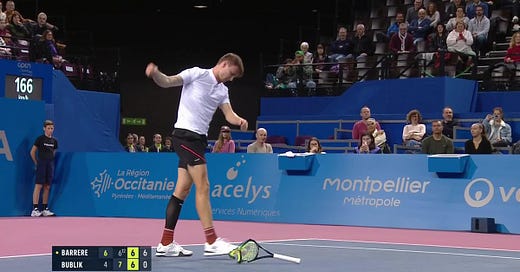On Wednesday, during the Round of 32 at the Open Sud de France, in Montpelier, Alexander Bublik, the current world #50 and the tournament’s reigning champion, smashed three rackets1 in succession after losing the first six points of his match’s deciding third-set tiebreak. (Context: Set tiebreaks in tennis are to seven, win by two.) I recommend watching the footage below with the sound on.
As reflected by the cascade of boos that accompanies Act I of Bublik’s meltdown, “racket abuse,” even in the most sympathetic cases, is still generally frowned upon by tennis fans and event organizers, doubly so when they’re French. Technically, the lowest fine a player can receive for smashing a racket is $250 on the men’s tour2, $2500 on the women’s side, and while that may sound like a gross double standard, anecdotal evidence suggests that the average male player will on an annual basis smash his racket about 25x as often as the worst offender on the WTA Tour, so, at least in monetary terms, the bill evens out. (Contrasting expectations of conduct for the genders in tennis is a story for another Substack post.)
The main gripe about smashing a racket is not just that it’s bad sportsmanship, but that it’s bad sportsmanship that could cause physical harm to the aggravated player, their opponent, and anyone in their vicinity, notably the children and teenagers who run around and whimsically retrieve the balls between serves. That’s reason enough to punish offending players at the professional level, since bystanders have gotten injured, in some instances severely, by errant balls and rackets in the past. However, the overwhelming rarity of these worst-case scenarios makes stopping short of match forfeitures, or longterm suspensions, feel about right as a punishment for racket abuse. Though the stakes are far lower, racket smashing can in the proper furious hands become an art, a spectacle that falls into the vestigial athletic grey areas of fighting in hockey or a pitcher intentionally beaming the batter in baseball. It’s all in good fun that’s a little bit bad3; the ego gasps as the id smiles wide with delight.
In the interests of transparency, I should divulge that I am a racket abuser, if not a full-blown smasher4. (We will not dwell on what would happen if my rackets were provided free of charge by sponsors, as they are to most Top 100 pros.) Abuse, even when directed towards inanimate objects, should never be rationalized or intellectualized; by any measure, it is shameful and immature and barbaric. With that said, racket abuse does usefully capture one of the things that I really love about watching and playing tennis. It’s a feature of the game that I’m hoping to make one of the primary preoccupations of this Substack, which will ideally help others identify, think about, and appreciate those fleeting moments when human idiosyncrasy and personality burst forth like a geyser from the rigid, unyielding geometric and sociocultural confines of the sport.
Take Alexander Bublik, for instance. An eccentric, inconsistent player from Kazakhstan, he is best known for hitting some of the dumbest conceivable trick shots at the least opportune moments, as well as saying he would rather lay in bed all day than play tennis. (“Nobody likes to go to their job,” was how he put it.) Yet there he is, smashing racket after racket after racket, as if losing a Round of 32 match at the Open Sud de France is a matter of life and death.
Where is that ferocious will to win the other 99% of the time for Bublik? How can someone who almost always seems to barely care, for an instant suddenly care so much? And isn’t there some poetry in the image of that garbled piece of advanced sports technology, lying in the middle of those crisp perfect lines, mangled beyond repair by emotion that feels primordial, irrepressible, infectious? No tennis player should ever smash their racket; they are our only companions on the unsure path ahead, whether it ends in victory or defeat, glory or ignominy. Like a beloved partner, they should be treated with compassion, trust, and respect, and in a better world they would be. But we live in this world, and no one writes novels about a happy marriage.
3!
The fines regularly end up in the thousands and tens of thousands of dollars, though.
😈
Pro Tip: You should always throw your racket so it lands flat on its face, not on its side, to minimize damage to the frame. I prefer to discus-toss my racket towards where I’ve set up my gear camp (after checking for innocent bystanders, of course).







